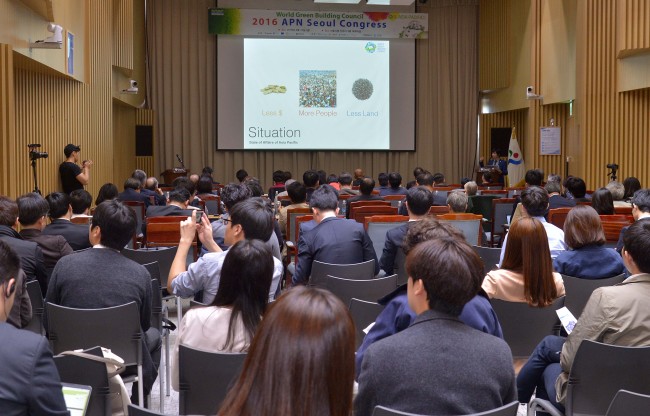Global experts talked about the need to change public misperception of green buildings, claiming it is cost-saving, healthier and eco-friendly at a conference in Seoul which kicked off Thursday for a three-day run.
The conference, being attended by around 150 representatives from government, academia and companies from the Asia-Pacific region, has become a platform for the experts to discuss ways to better achieve carbon emission reduction goals set by the Paris climate change conference in December.
“The basic concept of green building is to design it in a smart way from the beginning,” Dominika Czerwinska, director of the World Green Building Council said at the Congress on Friday, hosted by the Korea Green Building Council.
“Unlike the public misperception that green buildings are costly, they can be designed and built at minimum additional construction costs,” she said. In fact, because energy expenses are much lower, green buildings can be more profitable and the World Green Building Council is working on providing more analysis and case studies to support the business case.
Tai Lee Siang, vice chairman of the WGBC, also said that many people imagine plants and nature when they think of green buildings because of the color green.
“That is not a correct interpretation of green buildings. Green building is more a holistic concept rather than being just eco-friendly,” he said, adding, “The buildings are designed to save costs, making residents healthier and also protecting the environment.”
He gave one example of the latest drive of his country Singapore, where many buildings were entirely air conditioned. But, after noticing that was inefficient in the tropical country, companies began to remove air-conditioning systems in corridors and use natural ventilation instead.
“The new system saves costs and also made people feel more comfortable with natural breeze,” he said.
In Korea, JW Marriott Dongdaemun Square is an example of a green building. The hotel, which was built with advice from KGBC member companies, maximized energy efficiency with passive design techniques. As a result, it is able to save up to 30 percent in energy every year without incurring additional construction costs, according to Cha Chungha, vice chairman of the KGBC. This hotel is also Korea‘s first LEED Gold certified.
Despite such cases, it is still important for the government to make a strong drive for green buildings, industry experts said.
The Seoul Metropolitan Government also joined the conference and said the city feels the need to intensively manage carbon emissions in its buildings because it accounts for around 65 percent of total carbon emissions in the city.
“We aim to reduce carbon emissions by 26.9 percent in the building sector in Seoul by 2020 by improving energy efficiency, adopting a zero-net architecture system and raising public awareness,” Han Byung-yong, Seoul Metropolitan’s construction planning division chief, said.
By Shin Ji-hye ([email protected])


